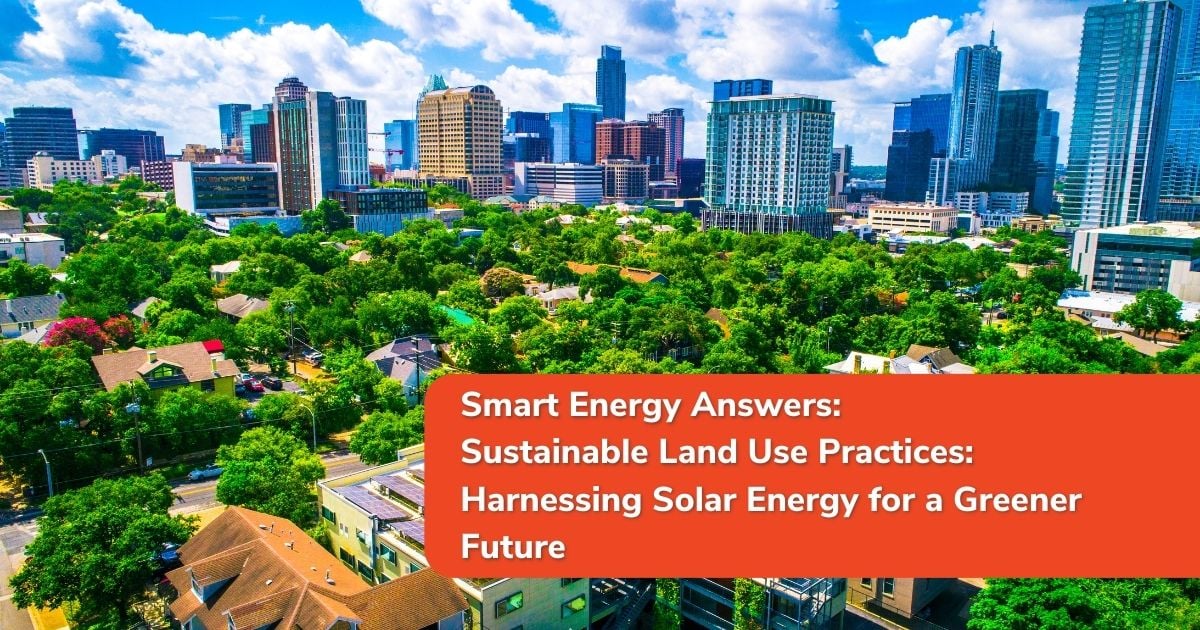Sustainable Land Use Practices: Harnessing Solar Energy for a Greener Future

Discover how the integration of solar energy into sustainable land use practices can pave the way for a more environmentally friendly future.
The Intersection of Sustainable Land Use and Solar Energy
Sustainable land use practices and solar energy are two important aspects of creating a greener future. By combining these two elements, we can maximize the benefits for both the environment and society. Sustainable land use involves managing land resources in a way that meets the needs of the present generation without compromising the ability of future generations to meet their own needs. Solar energy, on the other hand, is a renewable and clean source of power that can help reduce our reliance on fossil fuels and mitigate climate change.
The intersection of sustainable land use and solar energy offers numerous opportunities for innovation and sustainability. By harnessing solar energy on sustainable land, we can generate clean electricity while minimizing the environmental impact. This integration can contribute to a more sustainable and resilient energy system that supports the transition to a greener future.
Understanding the Potential of Solar Energy in Land Use Planning
Solar energy has immense potential when it comes to land use planning. Understanding this potential is crucial for developing effective strategies to harness solar power while maintaining sustainable land use practices. Solar energy can be harnessed through various methods, such as photovoltaic (PV) panels and solar thermal systems. These technologies can be integrated into buildings, infrastructure, and open spaces to generate clean electricity and heat.
In land use planning, it is important to identify suitable sites for solar installations. Factors such as solar resource availability, land suitability, and proximity to electricity infrastructure play a crucial role in determining the feasibility of solar projects. By understanding the potential of solar energy and considering these factors, we can optimize the placement of solar installations to maximize energy generation and minimize environmental impacts.
Identifying Suitable Sites for Solar Installations
Identifying suitable sites for solar installations is a key step in integrating solar energy into sustainable land use practices. Several factors need to be considered during site selection, including solar resource availability, land characteristics, and environmental considerations.
Solar resource availability refers to the amount of sunlight a site receives throughout the year. Sites with high solar resource availability are ideal for solar installations as they can generate more electricity. Land characteristics, such as slope, orientation, and shading, also play a role in determining the suitability of a site for solar installations. Flat and unshaded areas are generally more favorable for solar projects.
Environmental considerations are crucial in order to minimize the impact of solar installations on natural ecosystems. It is important to avoid sensitive areas such as protected habitats, wetlands, and prime agricultural land. By identifying suitable sites that have high solar resource availability, favorable land characteristics, and minimal environmental impact, we can ensure the effective integration of solar energy into sustainable land use practices.
Maximising Solar Energy Generation on Different Types of Land
Solar energy generation can be maximized on different types of land by adopting appropriate strategies and technologies. The suitability of land for solar installations depends on its characteristics and existing land use. Here are some approaches to maximize solar energy generation on different types of land:
- Rooftop Solar: Installing solar panels on rooftops of buildings can utilize underutilized space and generate clean electricity without occupying additional land.
- Brownfield Solar: Converting brownfield sites, such as abandoned industrial areas, into solar power plants can repurpose underutilized land for renewable energy generation.
- Floating Solar: Installing solar panels on bodies of water, such as lakes and reservoirs, can maximize land use efficiency and reduce water evaporation.
- Agrivoltaics: Integrating solar panels with agricultural activities can optimize land use by utilizing the same area for both solar energy generation and crop cultivation.
By adopting these approaches and technologies, we can maximize solar energy generation on different types of land while minimizing the use of additional land resources.
Balancing Solar Development with Environmental Conservation
Balancing solar development with environmental conservation is crucial to ensure the long-term sustainability of solar energy projects. While solar energy offers numerous environmental benefits, it is important to minimize any potential negative impacts on ecosystems and biodiversity.
To achieve this balance, it is important to conduct thorough environmental assessments before initiating solar projects. These assessments can help identify potential risks and develop appropriate mitigation measures. Additionally, incorporating nature-friendly design features into solar installations can help minimize impacts on wildlife and their habitats.
Collaboration between solar developers, environmental organizations, and local communities is key to achieving a balance between solar development and environmental conservation. By working together, we can ensure that solar energy projects contribute to a greener future without compromising the integrity of our natural ecosystems.
Integrating Solar Energy into Agricultural and Rural Landscapes
Integrating solar energy into agricultural and rural landscapes offers numerous benefits for farmers, landowners, and the environment. Solar installations can be strategically placed in agricultural areas to generate clean electricity while allowing for continued farming activities.
Agrivoltaics, which combines solar energy generation and crop cultivation, is a promising approach to integrate solar energy into agricultural landscapes. By utilizing the same land for both solar panels and crops, agrivoltaics optimizes land use efficiency and provides additional income streams for farmers.
In rural landscapes, solar installations can provide decentralized and renewable energy sources, reducing reliance on centralized power grids. This can lead to increased energy independence and resilience in rural communities.
By integrating solar energy into agricultural and rural landscapes, we can promote sustainable land use practices while contributing to the development of a cleaner and more resilient energy system.
Benefits of Solar Land Use Agreements for Landowners and Communities
Solar land use agreements offer several benefits for landowners and communities. These agreements provide opportunities for landowners to generate income from their land while contributing to the transition to renewable energy.
For landowners, solar land use agreements can provide long-term lease payments or revenue sharing from solar developers. This can be a stable source of income and diversify revenue streams. Additionally, solar installations can coexist with existing land uses, allowing landowners to continue other activities on their land.
Communities can also benefit from solar land use agreements. Solar projects can create job opportunities during construction and operation phases, stimulating local economic growth. Furthermore, solar installations contribute to the development of a clean energy infrastructure, reducing reliance on fossil fuels and mitigating climate change.
By entering into solar land use agreements, landowners and communities can actively participate in the sustainable development of solar energy and contribute to a greener future.
Overcoming Regulatory and Permitting Challenges for Solar Projects
Solar projects often face regulatory and permitting challenges that can delay or hinder their development. Overcoming these challenges is essential to streamline the deployment of solar energy and maximize its potential.
One of the main challenges is navigating the complex regulatory landscape. Solar developers need to comply with various federal, state, and local regulations related to land use, environment, and energy. Engaging with regulatory authorities early in the project development process and seeking expert guidance can help navigate these regulations more effectively.
Permitting processes can also pose challenges for solar projects. Obtaining the necessary permits for land use, construction, and operation can be time-consuming and require extensive documentation. Building relationships with local authorities and engaging in open communication can help expedite the permitting process.
By addressing regulatory and permitting challenges, we can create an enabling environment for the development of solar projects and accelerate the transition to a cleaner and more sustainable energy future.
Community Engagement and Stakeholder Collaboration in Solar Land Use
Community engagement and stakeholder collaboration are vital for the successful implementation of solar land use practices. Involving local communities, landowners, and other stakeholders from the early stages of project development fosters a sense of ownership and ensures that the project aligns with community needs and values.
Engaging with communities can help address concerns, build trust, and create a positive perception of solar energy projects. Public consultations, community meetings, and educational programs can facilitate dialogue and provide opportunities for stakeholders to voice their opinions and contribute to the decision-making process.
Collaboration with stakeholders, including environmental organizations, local businesses, and government agencies, can also enhance the sustainability and effectiveness of solar land use practices. By working together, we can identify and address potential challenges, find innovative solutions, and maximize the benefits of solar energy for all stakeholders involved.
Community engagement and stakeholder collaboration are essential for fostering a sense of ownership, building trust, and ensuring the long-term success of solar land use practices.
Conclusion: Advancing Sustainability Through Thoughtful Solar Land Use Practices
In conclusion, the integration of solar energy into sustainable land use practices presents a significant opportunity to advance sustainability and create a greener future. By harnessing solar power on suitable land, we can generate clean electricity while minimizing the environmental impact.
Understanding the potential of solar energy in land use planning, identifying suitable sites for solar installations, and maximizing solar energy generation on different types of land are key steps in this process. Balancing solar development with environmental conservation, integrating solar energy into agricultural and rural landscapes, and fostering community engagement and stakeholder collaboration are also essential.
Solar land use agreements offer benefits for landowners and communities, while overcoming regulatory and permitting challenges and ensuring thoughtful community engagement are crucial for the successful implementation of solar projects.
By adopting these best practices and embracing the integration of solar energy into sustainable land use practices, we can pave the way for a more environmentally friendly future and contribute to the global transition to clean and renewable energy sources.
%20(1).png?width=265&height=96&name=www.smartenergyanswers.com.auhs-fshubfsSmart%20Energy%20Answers%20Logo%20(HIRES)%20(1).png)

.png?width=514&height=121&name=Tesla%20Powerwall%203%20(new).png)








.webp?width=300&height=180&name=sigenergy-gold-installer-300x180%20(1).webp)